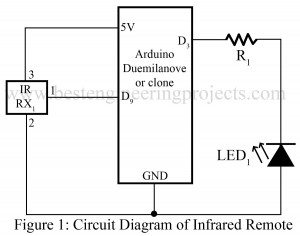Capacitors are one of the basic components of any electronic project. Now, here we taught you, how to test capacitor whether is short, open or working. The simple circuit of the capacitor tester is built around two general-purpose NPN transistors. This circuit posted here is used to test capacitors up to 1000 µF. The capacitor to be tested is connected at points A and B as shown in the circuit diagram (positive terminal at point B where negative terminal at point A). Working of the circuit Capacitor Tester cum Flasher When…
Read MoreCategory: Electronics Projects
High Powered Strobe Light Using Arduino
The project High Powered Strobe Light Using Arduino is the extended version of strobe light using arduino. Here, in this project we uses six high power Luxeon LED as used in previous project. This project show different strobe effect like flashing, fading, continuous illuminating etc. We can select any of this effect through serial monitor. Lets see the circuit diagram and how its work. Circuit Description of High Powered Strobe Light Using Arduino The circuit is shown in figure 1 and is designed around arduino uno board, N-Channel MOSFET, LM317…
Read MoreStrobe Light Using Arduino
Here is one another project which is useful in our daily life using aduino. As we had already posted “High Brightness LED Strobe Using NE555” using array of 36 LEDs now here we use single high brightness Luxeon LED. The circuit of strobe light using arduino is shown in figure 1. The potentiometer VR1 is used to control the flashing rate of strobe light. PARTS LIST OF STROBE LIGHT USING ARDUINO Resistor (all ¼-watt, ± 5% Carbon) R1 = 270 Ω R1 = 4 Ω/1W VR1 = 100 KΩ Semiconductors…
Read MoreSound VU Meter Using Arduino
Different gadgets have been introduced to meet our requirements ranging from the basic needs to the classy needs of humans. With this development in recent years, people have grown more sophisticated day by day. Hereby we have presented a circuit sound VU meter using Arduino to display the volume of noise picked up by a microphone. Circuit Description of Sound VU Meter using Arduino The push-to-on switch SW1 is used to change the mode of the sound VU meter. In normal mode, the LEDs just flicker up and down with…
Read MoreLED Dice Using Arduino
Here you will find the tutorial to build a simple LED dice using arduino. The software build will be reliable and perfect enough to implement it in a real working environment. This project is very helpful in to build a basic arduino system. Arduino technology is easy to use, efficient and reliable where it also allows dynamic and faster control. In this project we used random number generation technique. Every time you press the button, the LED’s roll for a while and glow a single LED. Figure 1 show the…
Read MoreDynamic Temperature Indicator and Controller Using Ardunio
Here is a standalone Dynamic Temperature Indicator and Controller Using Ardunio that also controls the electric appliance according to temperature. The use of Arduino technology makes this closed-loop feedback control system efficient and reliable. Arduino allows dynamic and faster control. Here we used a rotary encoder and liquid crystal display for more users friendly. The sensed and set temperature values are simultaneously displayed on the LCD panel in centigrade which can be changed Kelvin in scale. Circuit Description of Dynamic Temperature Indicator and Controller Using Arduino The circuit is programmed…
Read MoreCountdown Timer Using Arduino
The circuit here Countdown timer using Arduino is a simple circuit with the facility of the timer, this circuit is designed for 50 minutes timer but you can change it according to your requirement. Electronic circuits are usually designed for a specific purpose, which means one circuit performs only one task, in general cases. When this circuit is used, the time at which it is selected can be stored electronically while being displayed simultaneously. Talking about the circuit components, it uses an Arduino board, 7-segment display, PNP transistor, and a…
Read MoreTune Player Using Arduino
Arduino board is designed for working with digital signal or square wave signal. If we want to generate sine wave, we have to do little effort, because analog output from arduino is not true analog but a PWM output which turn board on and off very frequently. Here we use digital to analog converter to generate fine analog output. A digital to analog converter has a single output having number of digital input. PARTS LIST OF YUNE LAYER USING ARDUINO Resistor (all ¼-watt, ± 5% Carbon) R1 – R4, R8…
Read MoreInfrared Remote Controller Using Arduino
Here is projects called “Infrared Remote Controller Using Arduino” which allow you to control any type of electrical gadget using any infrared remote control. The project posted here records an infrared message from an existing remote control and give output as required. Here, we use EEPROM memory to store the infrared signal code so that we can use this remote even arduino board is disconnected. Circuit Description of Infrared Remote Controller Using Aruino:- The circuit of infrared remote controller is designed using an arduino board and a IR receiver module.…
Read MoreLED Chaser Circuit Using NE555
Various types of LED-based projects are already posted on bestengineeringprojects.com. Now, here is a simple project called LED chaser Circuit using NE555 in which 10 different LED is arranged in a column. The LED arranged in column glow from top to bottom, one at a time. Description of LED Chaser Circuit Using NE555 The circuit of the LED chaser is designed around a timer IC NE555 (IC1) and decade counter IC CD4017 (IC2). Here, IC1 is used in astable multivibrator mode which generates a clock pulse in a fixed interval…
Read More








